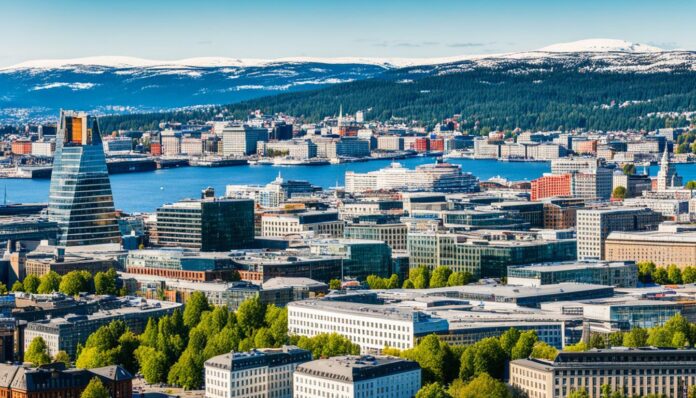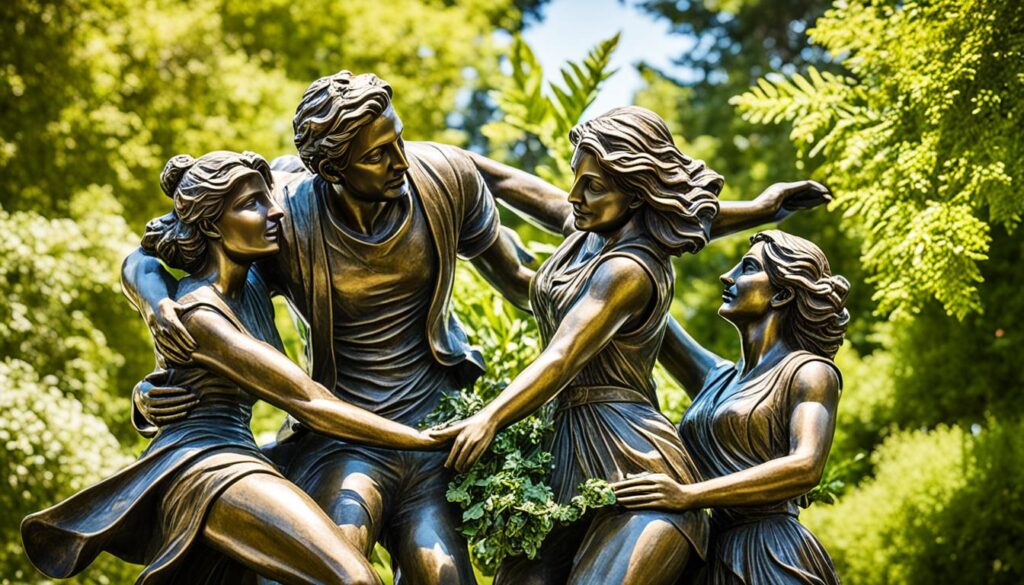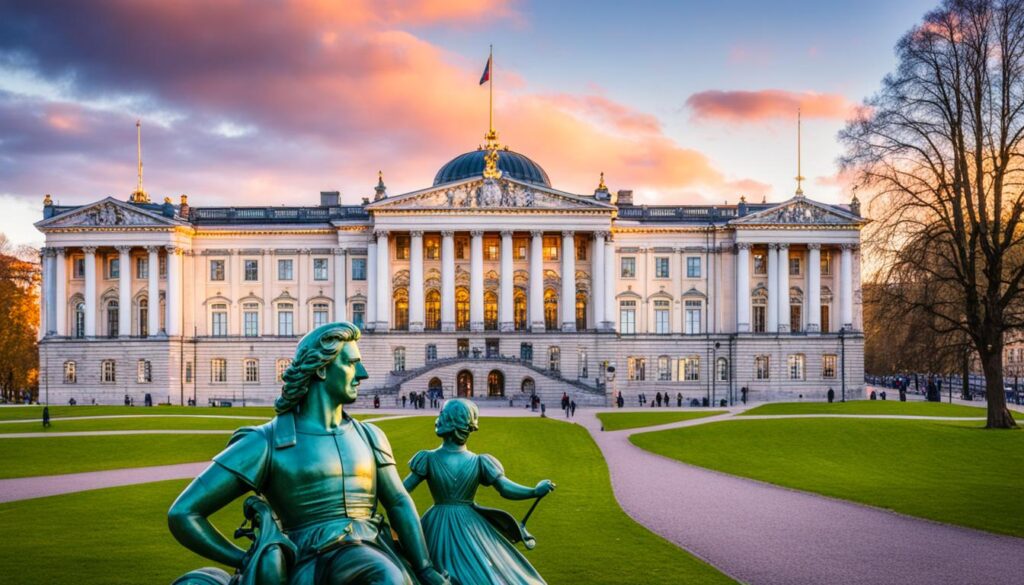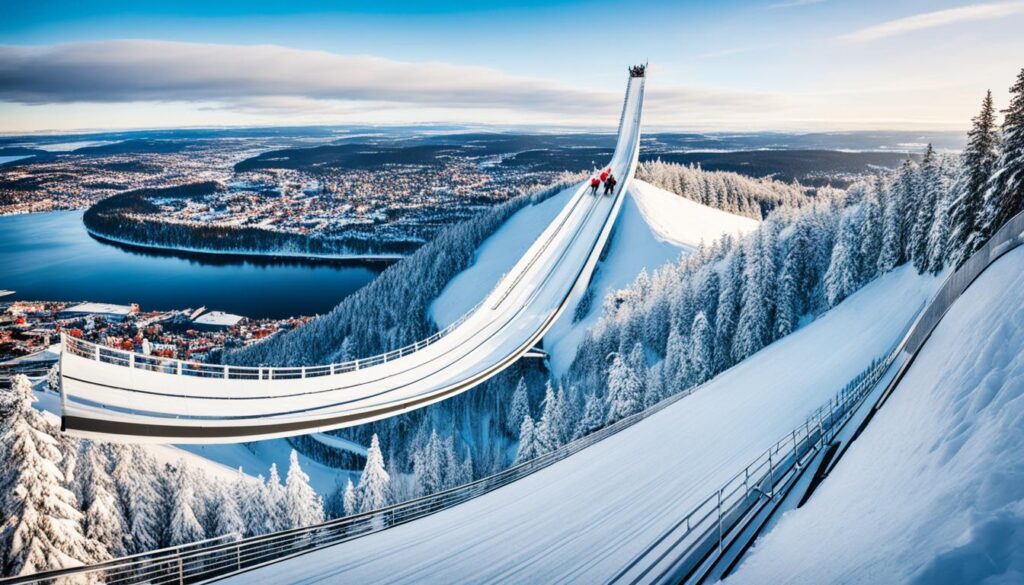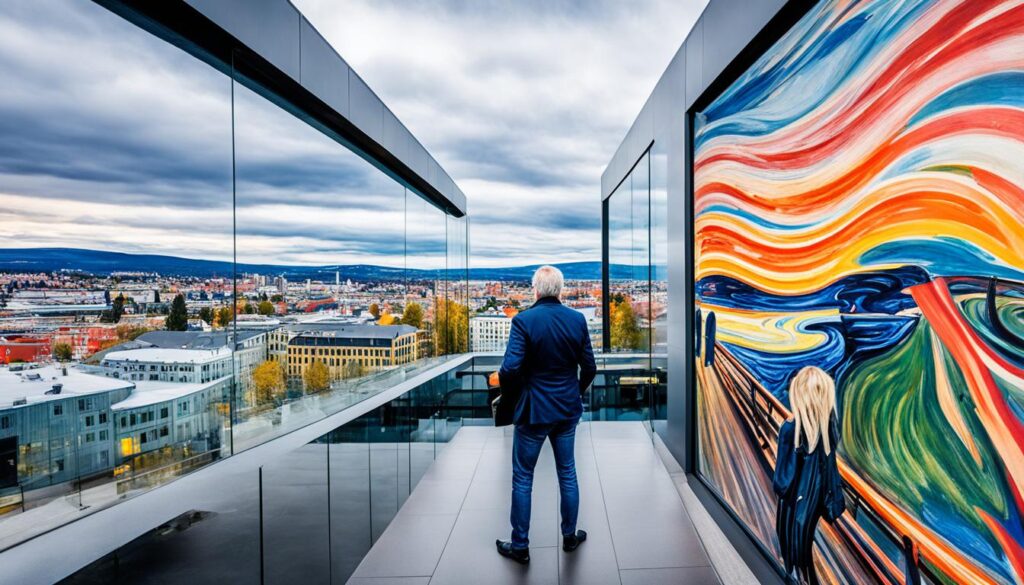What are the must-see attractions in Oslo besides the Viking Ship Museum? While the museum is undoubtedly a fascinating destination, Oslo has much more to offer visitors. From historical landmarks to cultural venues and stunning parks, there’s no shortage of things to see and do in the Norwegian capital.
Embark on a journey to discover the most enchanting and captivating tourist spots in Oslo, including the Royal Palace, Vigeland Park, and Aker Brygge, to name just a few. Get ready for an unforgettable experience full of sightseeing and exploration.
In this section, we will explore the best places to add to your Oslo travel itinerary and provide you with a comprehensive guide to Oslo attractions and sightseeing.
Vigeland Park – A Sculpture Paradise
When you visit Oslo, one of the most impressive attractions you cannot miss is Vigeland Park. The park, located in the Frogner neighborhood, features over 200 mesmerizing sculptures depicting human emotions, relationships, and experiences. Designed by Gustav Vigeland, one of Norway’s most renowned artists, the park is a perfect blend of art and nature, making it a unique destination for tourists and locals alike.
You can enjoy a peaceful stroll through beautifully landscaped gardens and take in the breathtaking view of the sculptures. The park is a perfect place for taking memorable pictures, engaging in solo reflection, or even having a picnic. Whether you are art enthusiasts or not, the sculptures in Vigeland Park will leave you in awe, and you’ll appreciate the effort and artistry put into its creation.
If you’re interested in learning more about the artist and his work, a visit to Vigeland Museum is highly recommended. The museum is at the entrance of Vigeland Park and features sketches, drawings, and other works from Gustav Vigeland’s portfolio.
The Statues of Vigeland Park
| Statues | Description |
|---|---|
| The Angry Boy | A bronze statue of a boy crying his eyes out, with a grim expression, symbolizing human sorrow. |
| The Wheel of Life | A massive granite sculpture, depicting the circle of life, with an old man holding a baby at the top, surrounded by figures at various stages of life. |
| The Monolith | A 46-foot tall granite tower, with figures intertwined and sculpted from a single rock, representing the human desire of reaching higher levels. |
| The Sinataggen | A bronze sculpture of a baby boy throwing a temper tantrum, symbolizing the rebellion against conformity. |
Vigeland Park is not just an Oslo park with sculptures; it is an immersive experience with art, landscape, and historical significance. It’s a perfect place to relax, take in some fresh air, and appreciate the beauty of art up close.
The Royal Palace – Regal Splendor
If you’re a fan of grand architecture and royal history, a visit to the Royal Palace in Oslo is a must. Built in the early 19th century, it is still the official residence of the Norwegian royal family. Wander through the Palace Gardens and admire the stunning façade of the building, a prime example of Oslo architecture.
Inside, you can explore the ceremonial halls adorned with antique furniture, sculptures, and paintings. Keep an eye out for the works of famous Norwegian artists on display, including Edvard Munch.
If you’re lucky, you may even catch a glimpse of the changing of the guard ceremony, which takes place daily. It’s a sight not to be missed!
| Est. Construction Date | Current Use | Architectural Style | Location |
|---|---|---|---|
| 1825 | Official residence of Norwegian monarchs | Neo-classical | Located in Oslo city center |
Fun fact: The balcony of the Royal Palace is traditionally where the Norwegian royal family greets the public and announces important events.
Holmenkollen Ski Jump – Thrill and Views
If you’re an adrenaline junkie looking for a thrilling experience, make sure to visit Holmenkollen Ski Jump. Located just outside Oslo, this iconic ski jump tower offers breathtaking panoramic views of the city, the Oslo Fjord, and the surrounding hills.
Learn about the history of ski jumping in Norway at the Ski Museum, located at the base of the tower. Admire the collection of vintage skis, sleds, and ski jumping equipment, and discover the fascinating stories behind this beloved winter sport.
Take the adventure to the next level by riding down the ski jump simulator, where you can experience the sensation of flying through the air like a professional ski jumper. Whether you’re a fan of winter sports or just looking for unparalleled views of Oslo, Holmenkollen Ski Jump is a must-visit destination.
Oslo Opera House – Architectural Wonder
Experience the awe-inspiring Oslo Opera House, an architectural masterpiece in the heart of the city. The Opera House is a triumph of contemporary architecture, featuring a stunning sloping roof that allows visitors to walk atop and enjoy an unparalleled view of the city.
The Opera House is not only a stunning feat of engineering but also one of Oslo’s prime cultural venues, attracting visitors from around the world. Catch a world-class opera, ballet, or concert performance in the state-of-the-art theater, renowned for its excellent acoustics and innovative design.
Don’t miss the opportunity to witness a rehearsal or behind-the-scenes tour, providing a unique glimpse of the inner workings of this magnificent institution.
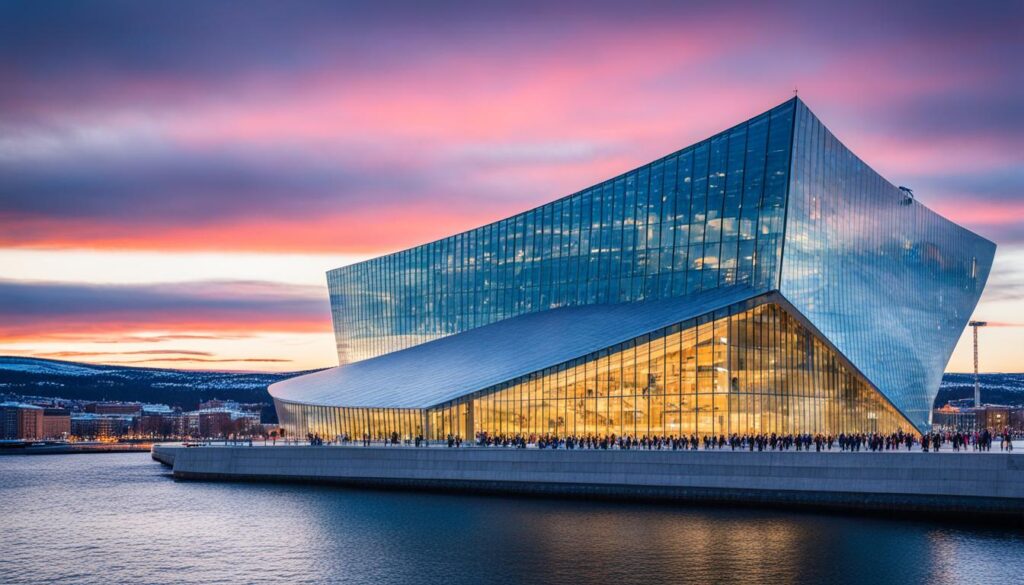
Akershus Fortress – Medieval History
Step back in time and experience Oslo’s rich history by visiting Akershus Fortress, an impressive medieval castle that has stood tall for centuries. Originally built in the 1300s as a royal residence, the fortress has since served many purposes throughout its long history, including as a prison, a military base, and even a royal mausoleum.
The fortress was also strategically located at the entrance of the Oslo Fjord, which made it an important defensive stronghold throughout Norway’s history. During World War II, the fortress was occupied by German forces, making it a symbol of the country’s resistance during the war.
Today, the fortress houses several museums, including the Norwegian Resistance Museum and the Norwegian Armed Forces Museum, where you can learn about the country’s military history and its role in World War II.
To truly appreciate the fortress, take a guided tour to learn more about its role in Norwegian history or simply wander around the grounds and enjoy the panoramic views of the city and Oslo Fjord. Don’t forget to bring your camera to capture the impressive architecture and beautiful scenery.
The Akershus Fortress is one of the remaining medieval fortresses of Norway that has survived through the centuries, offering a glimpse of the rich history of Oslo and the country.
The National Gallery – Artistic Gems
If you’re a lover of art, a trip to the National Gallery Oslo is a must. This museum is home to masterpieces by renowned artists such as Edvard Munch, including the iconic painting “The Scream,” as well as works by other Norwegian and international artists. Admire the intricate brushwork and bold colors of Munch’s expressionist paintings, which capture the angst and turmoil of the human psyche. You’ll also find a vast collection of art from the Norwegian Golden Age, featuring works by Johan Christian Dahl and Adolph Tidemand.
Tip: The museum has an extensive collection of lithographic prints, drawings, and photographs that showcase the evolution of modern and contemporary art.
The National Gallery – Exhibits
| Exhibit Name | Description |
|---|---|
| Edvard Munch’s “The Scream” | The iconic painting that has been interpreted in various ways throughout pop culture and has become synonymous with the existential angst of the modern era. |
| Norwegian Golden Age | A collection of works by Johan Christian Dahl and Adolph Tidemand, painters from the early 19th century who played a significant role in shaping Norway’s national identity through their depictions of Norwegian landscapes and folk culture. |
| European Art | A collection of paintings and sculptures from the Italian Renaissance, Dutch Baroque, and French Impressionism that highlights the museum’s global outreach and cultural exchange. |
Aker Brygge – Vibrant Waterfront District
When in Oslo, don’t miss the chance to explore the vibrant atmosphere of Aker Brygge, a popular waterfront district on the Oslo Fjord.
Aker Brygge is a bustling hub of activity, offering everything from stylish shops to delicious dining options. Explore the many restaurants overlooking the harbor and indulge in some of the best seafood Oslo has to offer. Or, take a leisurely walk along the waterfront promenade, enjoying the scenic views of the fjord.
With its unique blend of contemporary design and historic charm, Aker Brygge is a must-visit destination for anyone looking to experience the best of Oslo’s waterfront.
“There’s nothing quite like the atmosphere of Aker Brygge on a warm summer evening. Grab a seat outside one of the many restaurants and watch the boats go by on the fjord.”
The Munch Museum – A Brush with Greatness
If you’re a fan of art, a visit to the Munch Museum in Oslo is a must. The museum is dedicated entirely to the work of Norway’s most famous artist, Edvard Munch. Here, you can view a comprehensive collection of his paintings, drawings, and graphic works, providing insight into his unique style and artistic vision.
Munch’s most iconic work, “The Scream,” is part of the museum’s collection and is on permanent display. This piece, with its haunting portrayal of a screaming figure in a blood-red sky, has become one of the most recognized images in art history.
As you explore the galleries, admire Munch’s other famous works, such as “Madonna,” “Starry Night,” and “Vampire.” You’ll gain a deeper appreciation for Munch’s artistic brilliance and his contribution to the world of art.
Highlights:
- Comprehensive collection of Munch’s work
- Permanent display of “The Scream”
- Famous works such as “Madonna,” “Starry Night,” and “Vampire”
Oslo City Hall – Civic Pride
One of Oslo’s most iconic landmarks is the City Hall, a symbol of civic pride and an impressive example of Norwegian architecture. Located in the heart of the city, the building’s facade features a mix of traditional Nordic and modernist styles that is sure to catch your eye.
Step inside and prepare to be greeted with equally impressive interiors. The City Hall is adorned with intricate murals and artwork that depict Norwegian history and culture. Marvel at the grand ceremonial halls, which are used for major events such as the Nobel Peace Prize ceremony.
If you’re interested in learning more about the building’s history and architecture, guided tours are available for visitors. Discover fascinating details about the construction and design of the City Hall, which remains an enduring symbol of Oslo’s civic spirit.
Conclusion
If you’re planning a trip to Oslo, make sure to add these top attractions to your itinerary. From the stunning sculptures of Vigeland Park to the regal grandeur of the Royal Palace, Oslo offers a wealth of cultural and historical experiences. Whether you’re interested in the performing arts, outdoor adventures, or simply soaking up the local culture, there’s something for everyone in the Norwegian capital.
As you plan your visit, consult an Oslo travel guide to discover even more points of interest and hidden gems. With so many best places to visit in Oslo, you’ll want to make the most of your time in this vibrant city. From museums and historic landmarks to waterfront districts and trendy neighborhoods, Oslo has something to offer every traveler.
So pack your bags, book your tickets, and get ready to explore the wonders of Oslo. You’re sure to come away with unforgettable memories of this beautiful and fascinating city.




























